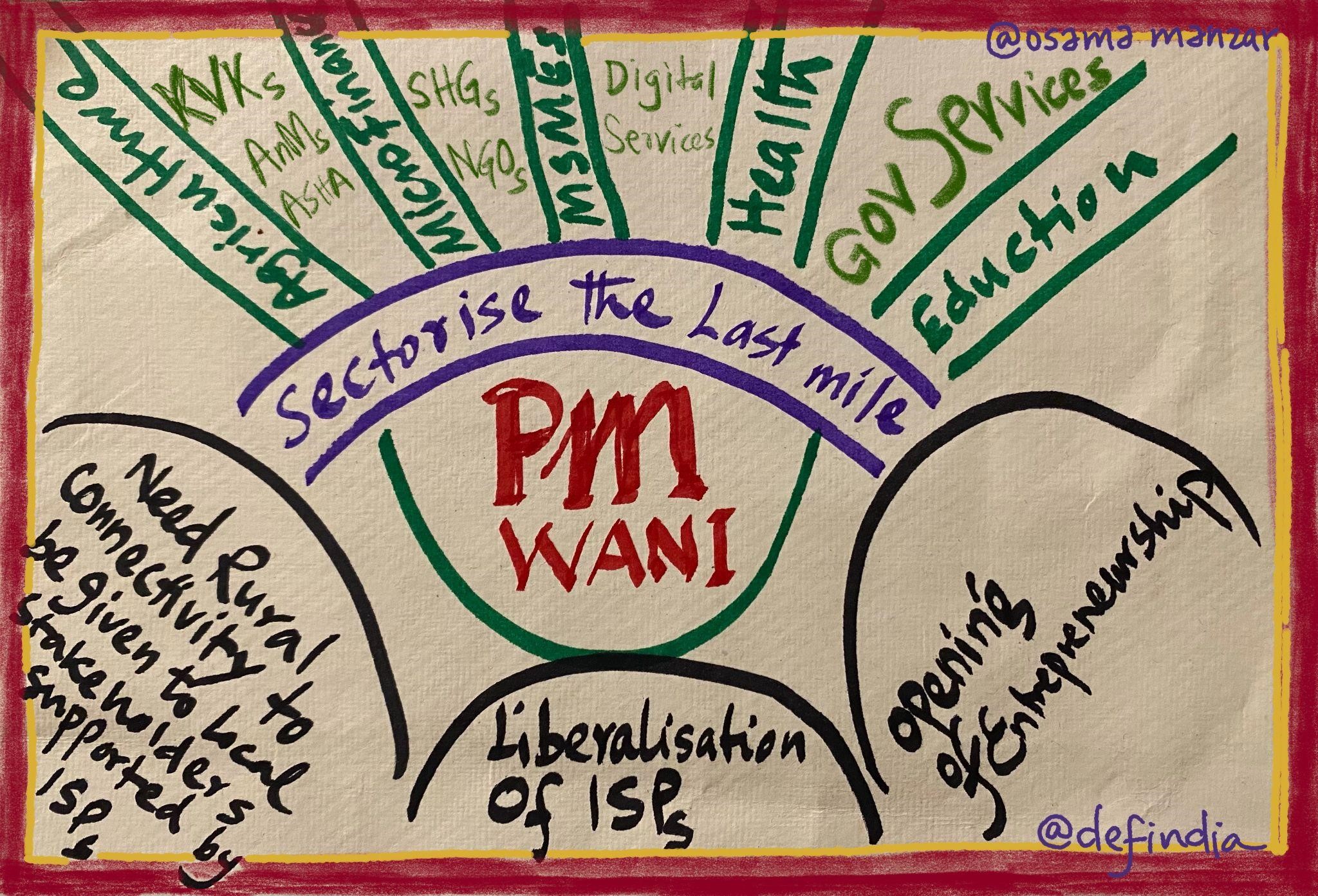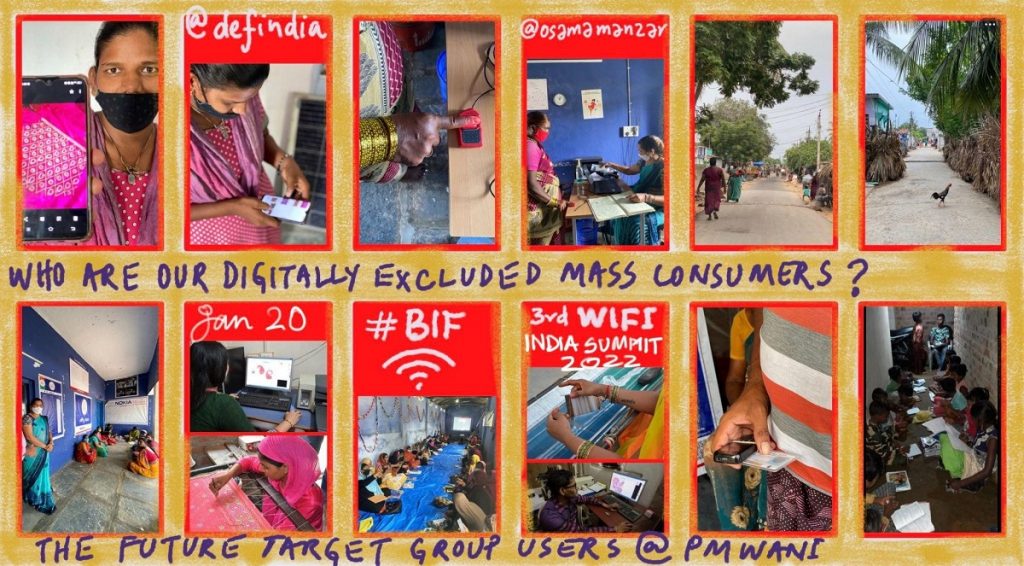Republished from Virtual Summit hosted by Broadband India Forum
 The “3rd WiFi India Virtual Summit” was organized by Broadband India Forum (BIF) on 22nd January, 2022. Following the decision by the Union Cabinet which approved the setting up of public WiFi networks across India through Public Data Offices (PDOs) without the requirement of license, registration or any other fees in December, 2020 discussions around its implementation and implications have been conducted annually. With 56,000 access points already deployed, the summit highlighted the impact of public hotspots on the employment sector by facilitating micro and small entrepreneurs to create more employment opportunities in rural and urban areas. One of the speakers Osama Manzar, founder and director of Digital Empowerment Foundation, brings out a whole new essence to the term ‘hotspot’ with real life instances supporting his ideas picked up from the ground through DEF’s reach and work around providing connectivity in rural parts of India.
The “3rd WiFi India Virtual Summit” was organized by Broadband India Forum (BIF) on 22nd January, 2022. Following the decision by the Union Cabinet which approved the setting up of public WiFi networks across India through Public Data Offices (PDOs) without the requirement of license, registration or any other fees in December, 2020 discussions around its implementation and implications have been conducted annually. With 56,000 access points already deployed, the summit highlighted the impact of public hotspots on the employment sector by facilitating micro and small entrepreneurs to create more employment opportunities in rural and urban areas. One of the speakers Osama Manzar, founder and director of Digital Empowerment Foundation, brings out a whole new essence to the term ‘hotspot’ with real life instances supporting his ideas picked up from the ground through DEF’s reach and work around providing connectivity in rural parts of India.
Following extract from the virtual summit broadcasted and recorded live at the recently held WiFi India Virtual Summit, 2022 is an excerpt of DEF’s perspective. The summit was hosted by Broadband India forum (BIF), formed to promote, support and enhance broadband connectivity in India.
K Manohar Raja (Moderator): WiFi is many things to many people. It is ubiquitous technology mostly but in the context of public WiFi and PM Wani, WiFi is about about democratic empowerment as well as digital transformation and who else better than our next speaker to talk about it who has done a body of work on in this area: Mr Osama Manzar, founder and director of Digital Empowerment Foundation, consumer focus address. Mr Manzar is a senior Ashoka Fellow and British Chevening scholar. He founded DEF which has digitally empowered more than 25 million people in India and several more in the global South. He has served on several boards of APC, World Summit awards, World Web Foundation, Down to Earth and many more. We are very eager to listen to you.

Osama Manzar: I want to talk this morning about everything that the Secretary highlighted: how are we having a problem at that end? We all know that we are more than 60% unconnected country, especially in rural India and these are the photos. As you can see these are the personally taken hardcore photographs from the ground: like fishermen villages, women entrepreneurs, SHG groups. Training going on in the villages there are dark spaces where tuitions are going alongside young students giving more tutelage to other people. Girls sit and design in rural areas but they need bandwidth and the last mile connectivity. People there have taken up the initiative of building these towers because there is no connectivity. And in one of the corners is a woman, an ASHA worker, sitting who is trying to login and update the data online. She has tried to find a center which has connectivity to get on with her compliance oriented data entry. And then there are some other little centers, where people who are handicapped are trying to get connected and in a corner there is a biometric machine which may not even be functional without which one can’t receive ration and many such examples. I want to highlight the actual hotspots; WiFi is not the hotspot. Hotspots are the people and institutions who are unconnected and those entrepreneurs who are actually burning with desire to get connected so that they can host their business in rural India. So the important question is what is the last mile that we need to look into? Now that we have the foundation that PM Wani gives- a structure, compliances and ease, we need to analyze how soon we can get that unlimited bandwidth to get connected. The reason I am highlighting this is because, we at Digital Empowerment Foundation have a reach in more than thousand locations all over the country and day in day out we work on connectivity. We work on the end and not on the means only.
Three important things that I want to emphasize are: who are the hotspots who are unconnected? Do we need access in a box? It is important to question this because from the outset, it looks like everybody is connected and

connectivity has reached everywhere through Airtel, Jio or BSNL. But why is still 60 percent of the population unconnected? Why do my videos buffer or fail to download? Metaverse, which Rajiv, (the head of public policy at Meta, formerly Facebook) mentioned, requires even higher bandwidth. Will that be possible? How will we create virtual or augmented realities? Because during the pandemic it is very much proven that we cannot afford to have a bandwidth deprived country. Connectivity is one part and it is very important to sectorize our last mile connectivity and make the “access” reach to people “in a box”. Education, health, MSMEs, microfinance, agriculture, KVKs (Krishi Vigyan Kendras), district libraries, SHG (Self Help Groups), members or ASHA workers are the hotspots which are currently unconnected and they are huge in number. There are about 22 million ASHA workers, 40 million micro-

enterprises (85 percent of all MSMEs fall under micro enterprise), thousands of community and public health centers and around 1.4 million schools that need either digital access and broadband connectivity. We have to find ways to democratize PM Wani in such a manner that, for example, the Department of Education becomes the ISP carrier of PM Wani and create an educational entrepreneurship for the last mile Internet access. Each sector’s institutional bodies would have to take individual responsibility to connect their stakeholders.
So I want to stress that PM Wani is actually required to be democratized and focus on the hotspots to create an entrepreneurship culture that is already there. We have to take up the role of hand holding as the groundwork already exists. We can no longer claim that there is a bureaucracy or lack of infrastructure. Because, the policy is there, infrastructure is there, framework is there; all we need is to identify all those hotspot institutions per sector, where PM Wani can be democratized and work on its building blocks to make them work on the ground. Thank you very much.
K Manohar Raja (Moderator): Fantastic insight sir! You have a completely different meaning of hotspot and I couldn’t agree more with you. It is those people who are hungry for data we need to reach out to. They are the hot spots. I am sure a lot of youngsters are listening to you and will heed with you.










